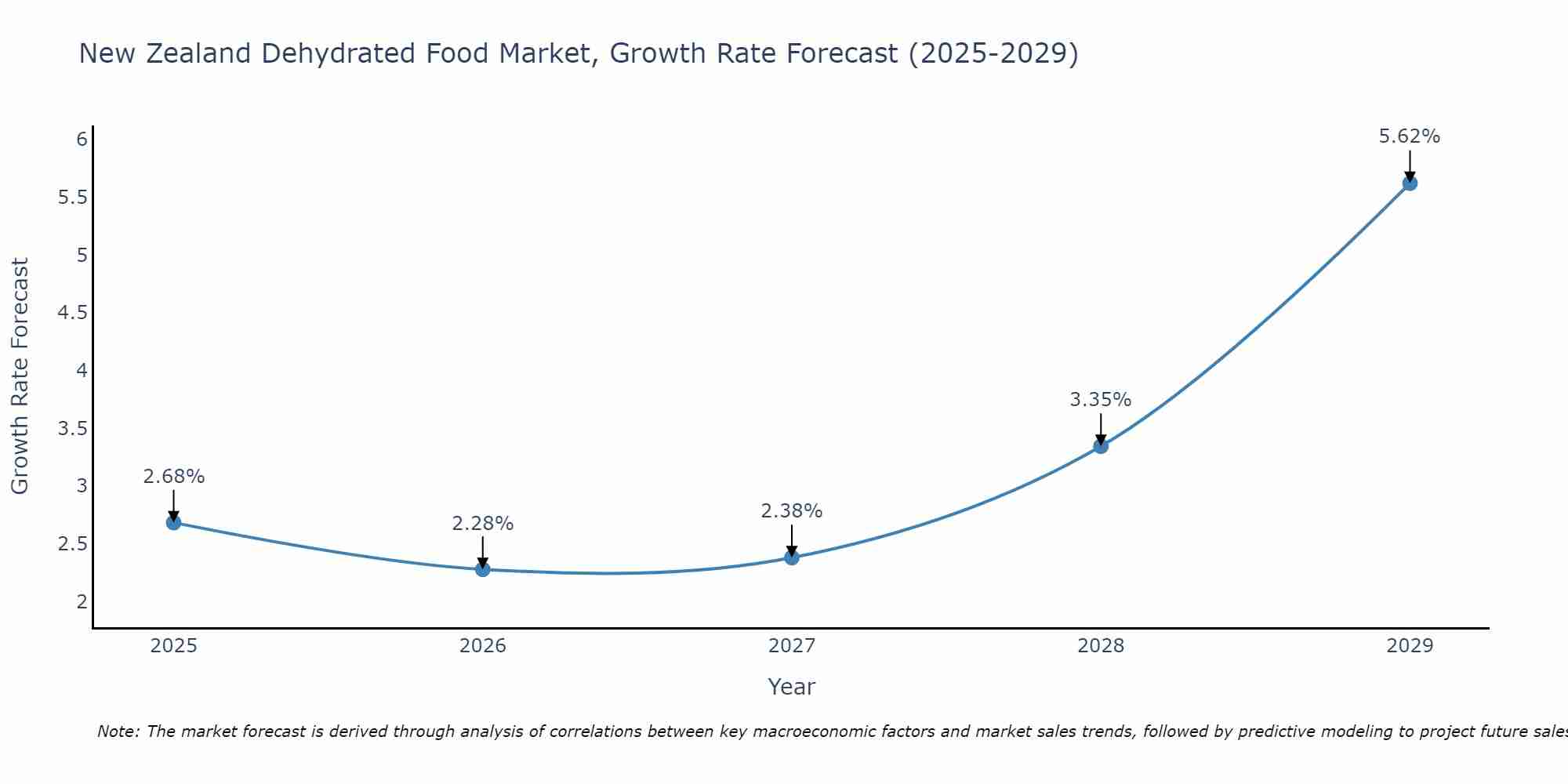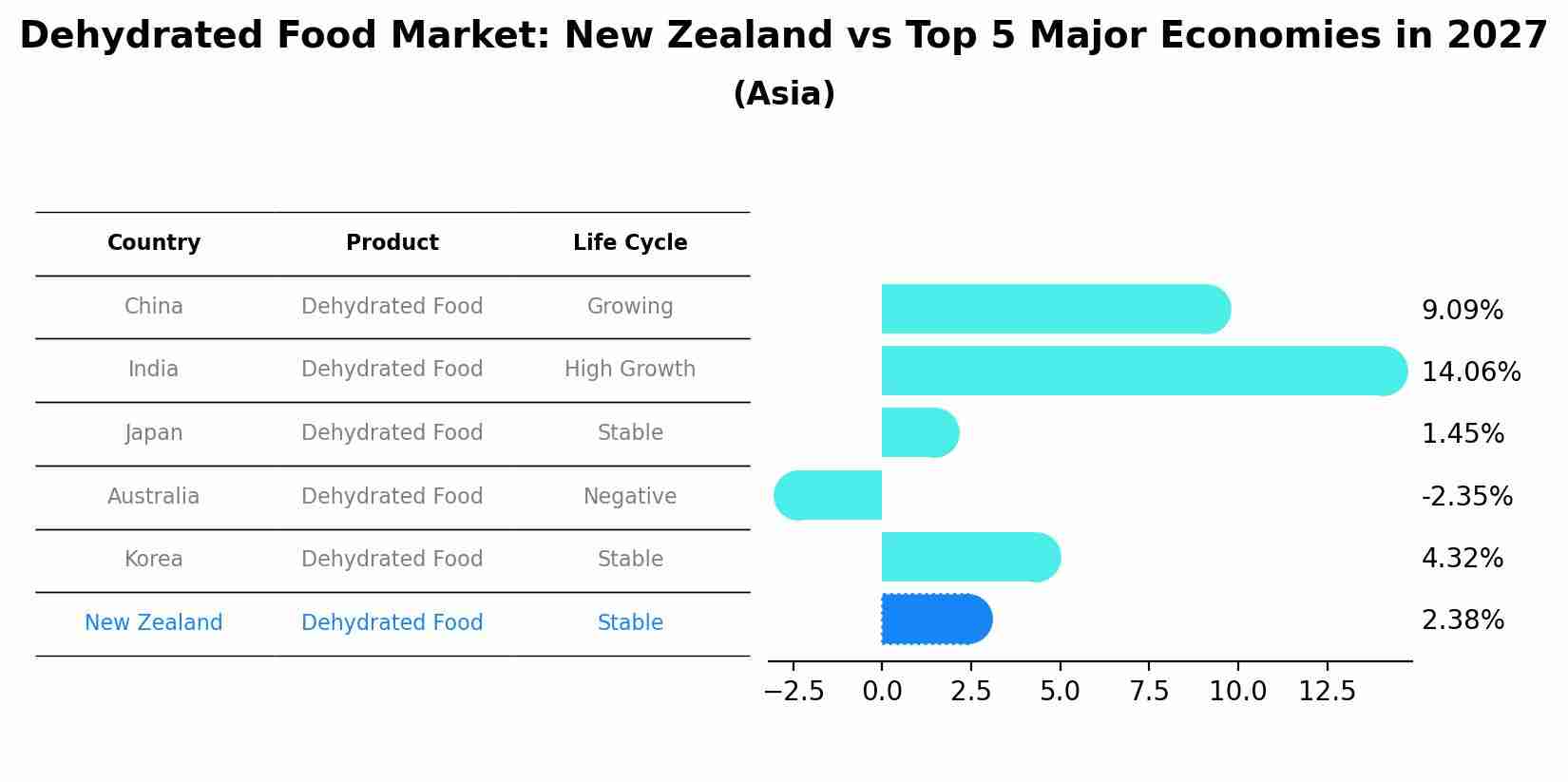New Zealand Dehydrated Food Market (2025-2031) | Trends, Segmentation, Growth, Analysis, Industry, Forecast, Companies, Value, Revenue, Outlook, Share & Size
| Product Code: ETC4837288 | Publication Date: Nov 2023 | Updated Date: Apr 2025 | Product Type: Market Research Report | |
| Publisher: 6Wresearch | Author: Sachin Kumar Rai | No. of Pages: 60 | No. of Figures: 30 | No. of Tables: 5 |
New Zealand Dehydrated Food Market Size Growth Rate
The New Zealand Dehydrated Food Market is projected to witness mixed growth rate patterns during 2025 to 2029. From 2.68% in 2025, the growth rate steadily ascends to 5.62% in 2029.

Dehydrated Food Market: New Zealand vs Top 5 Major Economies in 2027 (Asia)
By 2027, the Dehydrated Food market in New Zealand is anticipated to reach a growth rate of 2.38%, as part of an increasingly competitive Asia region, where China remains at the forefront, supported by India, Japan, Australia and South Korea, driving innovations and market adoption across sectors.

New Zealand Dehydrated Food Market Overview
In response to shifting consumer preferences and the need for convenient, shelf-stable food options, the dehydrated food market in New Zealand is experiencing steady growth. Dehydrated foods offer a lightweight, long-lasting alternative to fresh produce, making them ideal for camping, emergency preparedness, and snacking. With an emphasis on health and wellness, manufacturers are introducing innovative dehydrated food products that retain nutritional value and flavor.
Drivers of the market
The desire to extract actionable insights and drive competitive advantage from vast data sets is fueling the adoption of data mining tools in New Zealand. Businesses are leveraging advanced algorithms and predictive analytics techniques to discover hidden patterns, correlations, and trends in their data, enabling them to optimize processes, improve decision-making, and innovate.
Challenges of the market
In the New Zealand cranes rental market, challenges include maintaining a diverse and up-to-date fleet of cranes to meet varying customer demands. High operational costs, including maintenance, insurance, and storage, are significant concerns. The market is also influenced by economic cycles, with demand fluctuating based on construction and industrial activity. Ensuring compliance with safety and environmental regulations adds another layer of complexity. Moreover, competition from both local and international rental companies intensifies the need for competitive pricing and superior service.
Government Policy of the market
The Dehydrated Food market in New Zealand is expanding as consumers seek convenient and shelf-stable food options. Growing demand for lightweight and nutritious food products drives market growth.
Key Highlights of the Report:
- New Zealand Dehydrated Food Market Outlook
- Market Size of New Zealand Dehydrated Food Market, 2024
- Forecast of New Zealand Dehydrated Food Market, 2031
- Historical Data and Forecast of New Zealand Dehydrated Food Revenues & Volume for the Period 2021-2031
- New Zealand Dehydrated Food Market Trend Evolution
- New Zealand Dehydrated Food Market Drivers and Challenges
- New Zealand Dehydrated Food Price Trends
- New Zealand Dehydrated Food Porter`s Five Forces
- New Zealand Dehydrated Food Industry Life Cycle
- Historical Data and Forecast of New Zealand Dehydrated Food Market Revenues & Volume By Type for the Period 2021-2031
- Historical Data and Forecast of New Zealand Dehydrated Food Market Revenues & Volume By Spray-dried for the Period 2021-2031
- Historical Data and Forecast of New Zealand Dehydrated Food Market Revenues & Volume By Freeze-dried for the Period 2021-2031
- Historical Data and Forecast of New Zealand Dehydrated Food Market Revenues & Volume By Vacuum-dried for the Period 2021-2031
- Historical Data and Forecast of New Zealand Dehydrated Food Market Revenues & Volume By Drum-dried for the Period 2021-2031
- Historical Data and Forecast of New Zealand Dehydrated Food Market Revenues & Volume By Others for the Period 2021-2031
- Historical Data and Forecast of New Zealand Dehydrated Food Market Revenues & Volume By Product for the Period 2021-2031
- Historical Data and Forecast of New Zealand Dehydrated Food Market Revenues & Volume By Dried Processed Food for the Period 2021-2031
- Historical Data and Forecast of New Zealand Dehydrated Food Market Revenues & Volume By Dried Fruit & Vegetable for the Period 2021-2031
- Historical Data and Forecast of New Zealand Dehydrated Food Market Revenues & Volume By Dried Dairy for the Period 2021-2031
- Historical Data and Forecast of New Zealand Dehydrated Food Market Revenues & Volume By Dried Meat & Seafood for the Period 2021-2031
- Historical Data and Forecast of New Zealand Dehydrated Food Market Revenues & Volume By Others for the Period 2021-2031
- Historical Data and Forecast of New Zealand Dehydrated Food Market Revenues & Volume By Distribution Channel for the Period 2021-2031
- Historical Data and Forecast of New Zealand Dehydrated Food Market Revenues & Volume By Hypermarket/Supermarket for the Period 2021-2031
- Historical Data and Forecast of New Zealand Dehydrated Food Market Revenues & Volume By Convenience Stores for the Period 2021-2031
- Historical Data and Forecast of New Zealand Dehydrated Food Market Revenues & Volume By Online Retailing for the Period 2021-2031
- Historical Data and Forecast of New Zealand Dehydrated Food Market Revenues & Volume By Others for the Period 2021-2031
- New Zealand Dehydrated Food Import Export Trade Statistics
- Market Opportunity Assessment By Type
- Market Opportunity Assessment By Product
- Market Opportunity Assessment By Distribution Channel
- New Zealand Dehydrated Food Top Companies Market Share
- New Zealand Dehydrated Food Competitive Benchmarking By Technical and Operational Parameters
- New Zealand Dehydrated Food Company Profiles
- New Zealand Dehydrated Food Key Strategic Recommendations
Frequently Asked Questions About the Market Study (FAQs):
1 Executive Summary |
2 Introduction |
2.1 Key Highlights of the Report |
2.2 Report Description |
2.3 Market Scope & Segmentation |
2.4 Research Methodology |
2.5 Assumptions |
3 New Zealand Dehydrated Food Market Overview |
3.1 New Zealand Country Macro Economic Indicators |
3.2 New Zealand Dehydrated Food Market Revenues & Volume, 2021 & 2031F |
3.3 New Zealand Dehydrated Food Market - Industry Life Cycle |
3.4 New Zealand Dehydrated Food Market - Porter's Five Forces |
3.5 New Zealand Dehydrated Food Market Revenues & Volume Share, By Type, 2021 & 2031F |
3.6 New Zealand Dehydrated Food Market Revenues & Volume Share, By Product, 2021 & 2031F |
3.7 New Zealand Dehydrated Food Market Revenues & Volume Share, By Distribution Channel, 2021 & 2031F |
4 New Zealand Dehydrated Food Market Dynamics |
4.1 Impact Analysis |
4.2 Market Drivers |
4.3 Market Restraints |
5 New Zealand Dehydrated Food Market Trends |
6 New Zealand Dehydrated Food Market Segmentations |
6.1 New Zealand Dehydrated Food Market, By Type |
6.1.1 Overview and Analysis |
6.1.2 New Zealand Dehydrated Food Market Revenues & Volume, By Spray-dried, 2021-2031F |
6.1.3 New Zealand Dehydrated Food Market Revenues & Volume, By Freeze-dried, 2021-2031F |
6.1.4 New Zealand Dehydrated Food Market Revenues & Volume, By Vacuum-dried, 2021-2031F |
6.1.5 New Zealand Dehydrated Food Market Revenues & Volume, By Drum-dried, 2021-2031F |
6.1.6 New Zealand Dehydrated Food Market Revenues & Volume, By Others, 2021-2031F |
6.2 New Zealand Dehydrated Food Market, By Product |
6.2.1 Overview and Analysis |
6.2.2 New Zealand Dehydrated Food Market Revenues & Volume, By Dried Processed Food, 2021-2031F | 6.2.3 New Zealand Dehydrated Food Market Revenues & Volume, By Dried Fruit & Vegetable, 2021-2031F |
6.2.4 New Zealand Dehydrated Food Market Revenues & Volume, By Dried Dairy, 2021-2031F |
6.2.5 New Zealand Dehydrated Food Market Revenues & Volume, By Dried Meat & Seafood, 2021-2031F |
6.2.6 New Zealand Dehydrated Food Market Revenues & Volume, By Others, 2021-2031F |
6.3 New Zealand Dehydrated Food Market, By Distribution Channel |
6.3.1 Overview and Analysis |
6.3.2 New Zealand Dehydrated Food Market Revenues & Volume, By Hypermarket/Supermarket, 2021-2031F |
6.3.3 New Zealand Dehydrated Food Market Revenues & Volume, By Convenience Stores, 2021-2031F |
6.3.4 New Zealand Dehydrated Food Market Revenues & Volume, By Online Retailing, 2021-2031F |
6.3.5 New Zealand Dehydrated Food Market Revenues & Volume, By Others, 2021-2031F |
7 New Zealand Dehydrated Food Market Import-Export Trade Statistics |
7.1 New Zealand Dehydrated Food Market Export to Major Countries |
7.2 New Zealand Dehydrated Food Market Imports from Major Countries |
8 New Zealand Dehydrated Food Market Key Performance Indicators |
9 New Zealand Dehydrated Food Market - Opportunity Assessment |
9.1 New Zealand Dehydrated Food Market Opportunity Assessment, By Type, 2021 & 2031F |
9.2 New Zealand Dehydrated Food Market Opportunity Assessment, By Product, 2021 & 2031F |
9.3 New Zealand Dehydrated Food Market Opportunity Assessment, By Distribution Channel, 2021 & 2031F |
10 New Zealand Dehydrated Food Market - Competitive Landscape |
10.1 New Zealand Dehydrated Food Market Revenue Share, By Companies, 2024 |
10.2 New Zealand Dehydrated Food Market Competitive Benchmarking, By Operating and Technical Parameters |
11 Company Profiles |
12 Recommendations | 13 Disclaimer |
- Single User License$ 1,995
- Department License$ 2,400
- Site License$ 3,120
- Global License$ 3,795
Search
Related Reports
- Portugal Electronic Document Management Market (2025-2031) | Strategy, Consumer Insights, Analysis, Investment Trends, Opportunities, Growth, Size, Share, Industry, Revenue, Segments, Value, Segmentation, Supply, Forecast, Restraints, Outlook, Competition, Drivers, Trends, Demand, Pricing Analysis, Competitive, Strategic Insights, Companies, Challenges
- France Electronic Document Management Market (2025-2031) | Strategy, Consumer Insights, Analysis, Investment Trends, Opportunities, Growth, Size, Share, Industry, Revenue, Segments, Value, Segmentation, Supply, Forecast, Restraints, Outlook, Competition, Drivers, Trends, Demand, Pricing Analysis, Competitive, Strategic Insights, Companies, Challenges
- Portugal Occupational Health & Safety Services Market (2025-2031) | Strategy, Consumer Insights, Analysis, Investment Trends, Opportunities, Growth, Size, Share, Industry, Revenue, Segments, Value, Segmentation, Supply, Forecast, Restraints, Outlook, Competition, Drivers, Trends, Demand, Pricing Analysis, Competitive, Strategic Insights, Companies, Challenges
- Netherlands Occupational Health and Safety Services Market (2025-2031) | Strategy, Consumer Insights, Analysis, Investment Trends, Opportunities, Growth, Size, Share, Industry, Revenue, Segments, Value, Segmentation, Supply, Forecast, Restraints, Outlook, Competition, Drivers, Trends, Demand, Pricing Analysis, Competitive, Strategic Insights, Companies, Challenges
- Belgium and Luxembourg Facility Management Market (2025-2031) | Strategy, Consumer Insights, Analysis, Investment Trends, Opportunities, Growth, Size, Share, Industry, Revenue, Segments, Value, Segmentation, Supply, Forecast, Restraints, Outlook, Competition, Drivers, Trends, Demand, Pricing Analysis, Competitive, Strategic Insights, Companies, Challenges
- Russia Women Intimate Apparel Market (2025-2031) | Strategy, Consumer Insights, Analysis, Investment Trends, Opportunities, Growth, Size, Share, Industry, Revenue, Segments, Value, Segmentation, Supply, Forecast, Restraints, Outlook, Competition, Drivers, Trends, Demand, Pricing Analysis, Competitive, Strategic Insights, Companies, Challenges
- Africa Chocolate Market (2025-2031) | Size, Share, Trends, Growth, Revenue, Analysis, Forecast, industry & Outlook
- Global Hydroxychloroquine And Chloroquine Market (2025-2031) | Industry, Trends, Size, Outlook, Growth, Value, Companies, Revenue, Analysis, Share, Forecast
- Saudi Arabia Plant Maintenance Market (2025-2031) | Industry, Size, Growth, Revenue, Value, Companies, Forecast, Analysis, Share & Trends
- Taiwan Electric Truck Market (2025-2031) | Outlook, Industry, Revenue, Size, Forecast, Growth, Analysis, Share, Companies, Value & Trends
Industry Events and Analyst Meet
Our Clients
Whitepaper
- Middle East & Africa Commercial Security Market Click here to view more.
- Middle East & Africa Fire Safety Systems & Equipment Market Click here to view more.
- GCC Drone Market Click here to view more.
- Middle East Lighting Fixture Market Click here to view more.
- GCC Physical & Perimeter Security Market Click here to view more.
6WResearch In News
- Doha a strategic location for EV manufacturing hub: IPA Qatar
- Demand for luxury TVs surging in the GCC, says Samsung
- Empowering Growth: The Thriving Journey of Bangladesh’s Cable Industry
- Demand for luxury TVs surging in the GCC, says Samsung
- Video call with a traditional healer? Once unthinkable, it’s now common in South Africa
- Intelligent Buildings To Smooth GCC’s Path To Net Zero













